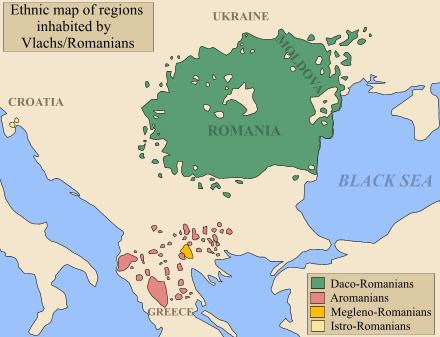Glottolog: east2714 | ||
 | ||
Subdivisions: RomanianDalmatian (? Italo-Dalmatian)Castelmezzano? | ||
The Eastern Romance languages are a group of Romance languages that developed in Southeast Europe from the local variant of Vulgar Latin. Today, the group consists of Romanian and three other related minor languages, Aromanian, Megleno-Romanian and Istro-Romanian.
Contents
Some classifications include also the Italo-Dalmatian languages. When Italian is classified as Western Romance, Dalmatian generally remains in Eastern. However, this article is concerned only with Eastern Romance in the narrow sense, without Italian nor Dalmatian.
The Eastern Romance languages, in their narrow conception, diverged from a common proto-language. They formed until recently a dialect continuum, spread across the Balkan Peninsula and the Carpathian arc. In the words of latin origin, they share the same phonetic changes, with the exception of very few recent evolutions. So, their classification as separate languages is controversial and is rejected by a majority of romanian linguists.
The Eastern Romance languages are sometimes known as the Vlach languages, being so designated especially by the speakers of Southern-Slavic languages.
History
An asymmetrical merger of Latin vowels, with /i/ merging with /ē/ and /e/ but /u/ merging with /ū/, sets off Eastern Romance from the symmetrical merger of /u/ with /ō/ and /o/ found in Western Romance. However, while this persists today in only a few isolated dialects in western Basilicata, such as Castelmezzano dialect, as well as Dalmatian and the Romanian languages, there is evidence that it once occurred throughout southern Italy.
Several hundred years after the Roman Empire's dominance of the region, the local form of Vulgar Latin developed into Proto-Romanian, a language which had undergone most of the phonetic and grammatical changes characteristic to modern Romanian with respect to Latin. Subsequently Proto-Romanian diversified and developed into a dialect continuum. Due to foreign invasions that displaced Romance speaking populations and submerged vast areas occupied by intermediate dialects (see Romania in the Dark Ages), surviving Proto-Romanian eventually split into separate varieties:
This classification is merely geographical. So, Emanuel Vasiliu classifies Istro-Romanian with Daco-Romanian, as a North-Danubian language. And most linguists estimate that Megleno-Romanian shows mixed features, being intermediate between the Daco-Romanian and Aromanian.
As another consequence of the foreign invasions, the Proto-Romanian was influenced at various degrees by Slavic and other languages. The Slavic influence was more massive in the central part of the domain, from where originated the actual speakers of Megleno-Romanian, Istro-Romanian, Banat sub-dialect and, in a less measure, the Wallachian sub-dialect. Here and there, and especially in this central part, the Proto-Romanian became insular and eventually disappeared. Notorious examples of populations that once spoken Eastern Romance languages, entirely slavized today, are:
This process of assimilation continues until today, the South-Danubian languages and some varieties of the Daco-Romanian spoken outside Romania being highly endangered.
The place where Proto-Romanian formed is still under debate; most historians put it to the north of the Jireček Line, separating the Latin speaking areas from the Greek speaking ones. (See: Origin of Romanians). Proto-Romanian is not the only Romance idiom that would develop in the Balkan Peninsula, if the invasion of the Germans, Slavs and Hungarians wouldn't occur. According to Haralambie Mihăescu, Aquilea, Noricum and Pannonia Superior would have, as well as the Dalmatia, their own original Romance idiom, different from the Romanian. The latin loans in Greek and Albanian show phonetic changes foreign to those specific to Romanian, too. It remains to Proto-Romanian only the most eastern part of the Roman domain in the Balkan Peninsula. According to Alexandru Rosetti, the Proto-Romanian formed in Dacia, Moesia Superior and Inferior, Dardania and Pannonia Inferior. What is contested by most foreign historians , but is fervently supported with proofs by most of their romanian colleagues, is the fact that the Proto-Romanian could have been formed in Dacia, after the retreat of the Roman army in the 3rd century.
Common features
The Proto-Romanian branch was one of the earliest language groups to be isolated from the larger Latin family. As such, the languages contain a few words that were replaced with Germanic borrowings in Western Romance languages, for example, the word for white is derived from Latin "albus" instead of Germanic "blank".
They also share a few sound changes with the western Romance languages: some with Italian, such as [kl] > [kj] (Lat. clarus > Rom. chiar, Ital. chiaro) and also a few with Dalmatian, such as [gn] > [mn] (Lat. cognatus > Rom. cumnat, Dalm. comnut). However, most of them are original, see: Latin to Romanian sound changes.
The languages that are part of this group have some features that differentiate them from the other Romance languages, notable being the grammatical features shared within the Balkan language area as well as some semantic peculiarities, such as lume ("world") being derived from Latin lumen ("light"), inimă ("heart") being derived from Latin anima ("soul"), etc.
The languages also contain a Paleo-Balkanic substrate of a few hundreds of words, shared with Albanian.
